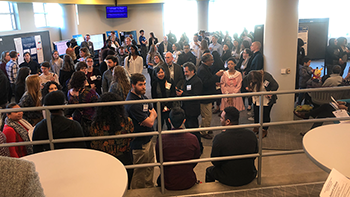Validation of Drug Like Inhibitors for the New Proton Activated Chloride Channel
Description/Abstract/Artist Statement
PAC, proton-activated chloride channel, is an evolutionarily conserved membrane channel that is activated by extracellular acidification. The molecular identity of PAC is recently cloned, opening the door for further investigations on the channel. Emerging evidence showed that PAC was involved in acid induced cell death, and that mice without the PAC channel showed better recovery after an ischemic stroke model. Yet, pharmacological tools that specifically inhibit PAC are lacking. To overcome this limitation and potentially provide treatment for acidosis related diseases, a high-throughput screening was performed and more than 2000 FDA (Food and Drug Administration) proved drugs were screened and repurposed as potential inhibitors of PAC.
During this experiment, the top three drugs found in the screening, Resveratrol, Neostigmine Bromide and 3-Formyl Rifamycin were tested as PAC inhibitors. It has been hypothesized that those three drugs should inhibit acidic induced PAC current. Whole-cell patch clamp experiment was conducted in HEK293 cells to confirm their inhibition on PAC. HEK293 cells were perfused with acidic solution to evoke PAC, and inhibitors were applied together with acidic solution after PAC reached complete opening. The reduction of currents were recorded and compared after the application of inhibitors. 20uM Resveratrol showed 32% inhibition on PAC, while 20uM Neostigmine Bromide showed 50% inhibition and 20uM 3-Formyl Rifamycin showed 52% inhibition when perfusing with pH=4.6 solutions. Our studies suggest that all three drugs showed significant inhibition of PAC channel activity, providing promising pharmacological means to manipulate PAC in vivo.
Faculty Advisor/Mentor
Zhaozhu Qiu, Ph.D.
Presentation Type
Poster
Disciplines
Cellular and Molecular Physiology | Life Sciences | Physiology
Session Title
Poster Session
Location
Learning Commons, Atrium
Start Date
2-8-2020 8:00 AM
End Date
2-8-2020 12:30 PM
Validation of Drug Like Inhibitors for the New Proton Activated Chloride Channel
Learning Commons, Atrium
PAC, proton-activated chloride channel, is an evolutionarily conserved membrane channel that is activated by extracellular acidification. The molecular identity of PAC is recently cloned, opening the door for further investigations on the channel. Emerging evidence showed that PAC was involved in acid induced cell death, and that mice without the PAC channel showed better recovery after an ischemic stroke model. Yet, pharmacological tools that specifically inhibit PAC are lacking. To overcome this limitation and potentially provide treatment for acidosis related diseases, a high-throughput screening was performed and more than 2000 FDA (Food and Drug Administration) proved drugs were screened and repurposed as potential inhibitors of PAC.
During this experiment, the top three drugs found in the screening, Resveratrol, Neostigmine Bromide and 3-Formyl Rifamycin were tested as PAC inhibitors. It has been hypothesized that those three drugs should inhibit acidic induced PAC current. Whole-cell patch clamp experiment was conducted in HEK293 cells to confirm their inhibition on PAC. HEK293 cells were perfused with acidic solution to evoke PAC, and inhibitors were applied together with acidic solution after PAC reached complete opening. The reduction of currents were recorded and compared after the application of inhibitors. 20uM Resveratrol showed 32% inhibition on PAC, while 20uM Neostigmine Bromide showed 50% inhibition and 20uM 3-Formyl Rifamycin showed 52% inhibition when perfusing with pH=4.6 solutions. Our studies suggest that all three drugs showed significant inhibition of PAC channel activity, providing promising pharmacological means to manipulate PAC in vivo.

